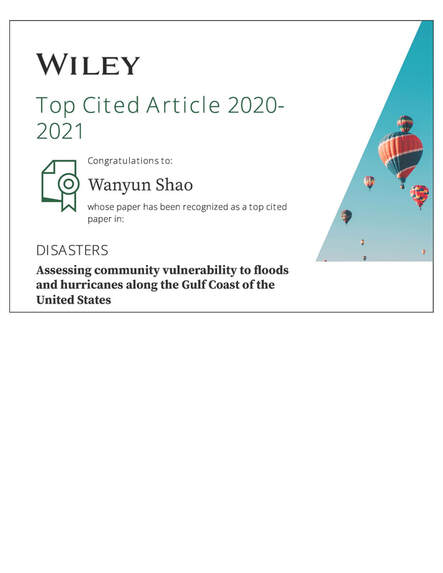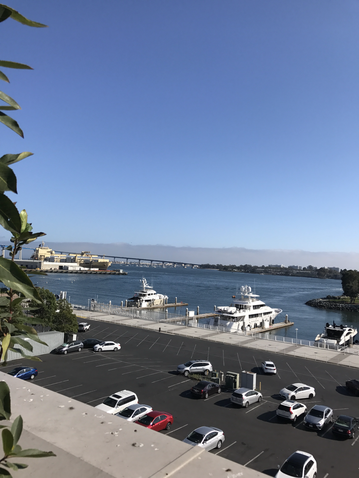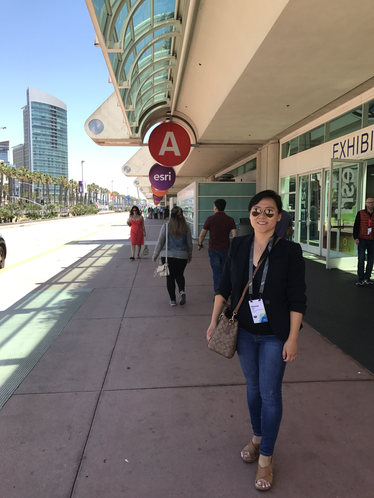|
In a new paper that is published in Natural Hazards, we applied multiple algorithms to model flood susceptibility in New Orleans. Please find the abstract below:
"Machine learning (ML) models, particularly decision tree (DT)-based algorithms, are being increasingly utilized for flood susceptibility mapping. To evaluate the advantages of DT-based ML models over traditional statistical models on flood susceptibility assessment, a comparative study is needed to systematically compare the performances of DT- based ML models with that of traditional statistical models. New Orleans, which has a long history of flooding and is highly susceptible to flooding, is selected as the test bed. The primary purpose of this study is to compare the performance of multiple DT-based ML models namely DT, Adaptive Boosting (AdaBoost), Gradient Boosting (GdBoost), Extreme Gradient Boosting (XGBoost) and Random Forest (RF) models with a traditional statistical model known as Frequency Ratio (FR) model in New Orleans. This study also aims to identify the main drivers contributing to flooding in New Orleans using the best performing model. Based on the most recent Hurricane Ida-induced flood inventory map and nine crucial flood conditioning factors, the models’ accuracies are tested and compared using multiple evaluation metrics. The findings of this study indicate that all DT-based ML models perform better compared to FR. The RF model emerges as the best model (AUC = 0.85) among all DT-based ML models in every evaluation metrics. This study then adopts the RF model to simulate flood susceptibility map (FSM) of New Orleans and compares it with the prediction of FR model. The RF model also demonstrates that low elevation and higher precipitation are the main factors responsible for flooding in New Orleans. Therefore, this comparative approach offers a significant understanding about the advantages of advanced ML models over traditional statistical models in local flood susceptibility assessment."
0 Comments
11/17/2023 2 Comments Our new paper on changing community vulnerability in the U.S. Mobile Bay from 2000 - 2020Our new paper is published in the journal Applied Spatial Analysis and Policy. Below is the abstract:
"The coastal community is confronted with heightened risks posed by climate change. Mobile Bay in the United States is a large estuarine system along the Gulf of Mexico (GOM) coast, providing critical ecosystem services for the nation. This region is however subject to increased urbanization and uncertain impacts of climate change. To ensure sustainability of this important ecosystem, it is imperative to examine the changing spatial patterns of community vulnerability to environmental changes in this region. Using data from the U.S. Census of multiple years, we investigate the changing spatial patterns of social vulnerability at the census block group level in Mobile Bay consisting of Mobile County and Baldwin County over the past 20 years (2000 – 2020). Additionally, we utilize hotspot and cluster analyses to formalize the observations of the spatiotemporal changes. Further, we examine how land use and land cover (LULC) changes co-occur with social vulnerability changes across Mobile Bay. We identify several hotspots where land cover has been converted to urban land and social vulnerability has increased. The investigation of the spatial patterns over a relatively long period helps to deepen the insight into the dynamic spatiotemporal changes of social and environmental vulnerability. This insight can better inform future plans to cope with climate change and ensure sustainability. Specifically, hotspots that have undergone urbanization and increased social vulnerability demand special attention from policy makers for future risk mitigation and disaster planning." Our paper using participatory GIS to measure accessibility of people with movement disabilities has been published in Applied Geography. Below please find the abstract:
"Although evaluation of the accessibility of people with disability (PWDs) is necessary to design effective transportation policy measures to ensure better mobility for PWDs, little empirical research are available on this subject. This study thus aims to address this gap by developing a methodological framework and applying this framework to assessing the accessibility of earthquake evacuation routes for people with movement-related disabilities (PMDs), one type of PWDs, in the city of Dhaka, Bangladesh. Specifically, this comprehensive accessibility index is composed of four components including accessibility from home to shelter, perceived accessibility of evacuation route, accessibility of entrance of the shelter, perceived accessibility of internal circular space and entrance of the residential building. Participatory GIS approach is employed in the data collection 455 PMDs were surveyed from 13 wards of Dhaka. Accessibility of each considered parameter and the overall indicator are poor in most cases. 45.2% of the wards are found to have relatively poor conditions of overall accessibility during evacuation. Relations of various accessibility components with socio-economic factors and level of disability are examined as well. PMDs with higher levels of disabilities and older PMDs perceive lower accessibilities of evacuation routes, circulation space, and entrance gate of residence, while male and more educated PMDs perceive circular space and entrance gate of residence to be more accessible." 8/2/2022 0 Comments Open PhD Position – coastal community resilience, risk perceptions, community engagement, Nature Based Solution The Environmental Decision Making Lab at the Department of Geography of the University of Alabama seeks a geography PhD student to focus on coastal community resilience, risk perceptions, community engagement under the theme of Nature Based Solution (NBS). The broader research team is focused on developing actionable design guidance for NBS (i.e., wetland restoration) along the US Gulf Coast. Our highly interdisciplinary group includes social scientists, wetland ecologists, water resource engineers, and government agency partners. Our goal is to develop guidance for wetland restoration activities optimized to reduce flooding and increase coastal community resilience. To accomplish this goal, we will employ a combination of community engagement, wetland plant community characterization, and state-of-the-art hydrologic and hydraulic modeling.
The successful candidate will be expected to start in spring, 2023. The candidate will work closely with social scientists, wetland ecologists, and water resource engineers, and our government partners to develop, assess, and communicate NBS design alternatives by engaging stakeholders in a knowledge co-production fashion. The candidate will be expected to work with the team to develop a plan for stakeholder engagement meetings, organize and facilitate stakeholder engagement activities, collect the data from the meetings, analyze the data, and report findings in peer-reviewed manuscripts. Through this work, the candidate will also be expected to develop hypothesis driven research based on their interests. The ideal candidate will have MS degrees in a relevant field (i.e., geography, urban and regional planning, environmental sociology, ecology, environmental science, or closely related field). The candidate should be excited about working on an interdisciplinary team; interacting with community partners, and conducting both basic and applied research. Further, experience with statistical analysis and programs (e.g., R, Stata, SPSS) and geographic information systems (e.g., ArcGIS, QGIS) are required. Experience with textual analysis programs (e.g., NVivo) is preferred but not required. Additionally, experience with scripting languages (e.g., R, Python, or Matlab) are preferred but not required. For more information, please contact Dr. Wanyun Shao ([email protected]) Our paper on community vulnerability to floods and hurricanes in the Gulf Coast has been recognized as the most cited paper in the journal Disasters.
10/1/2020 2 Comments A Ph.D opportunity My research group Environmental Decision Making at the Department of Geography at the University of Alabama is accepting applications for a Ph.D student with research assistantship, in social dimension of hazards in general and flood hazards in particular. The assistantship provides a stipend plus tuition remission.
The successful applicant will work with me and two research groups at the Department of Civil, Construction, and Environmental Engineering and will be involved in projects focused on human dimension of flood hazards. Qualified candidates should have a Master’s degree in Geography, Environmental Studies/Sciences, Planning or a related discipline. Candidates should have a strong interest in the intersection of social and physical dimensions of hazards and be eager to work in an interdisciplinary environment. Experience in quantitative data analysis, survey design, geographic information systems (GIS) are desired. Strong oral and written communication skills are required. For more information about this assistantship, please contact me at [email protected] well in advance of February 15, 2021 (the application deadline). Please include a copy of your CV, unofficial academic transcripts, and a brief personal statement that highlights skills relevant to the position. For more information about the department, please see https://geography.ua.edu/. 12/29/2019 2 Comments A new paper in Scientific Reports In a new paper, we assessed the socio-economic vulnerability to flash floods across the contiguous U.S. This paper has been published in Scientific Reports (a Nature journal). For more information, below please find the abstract:
"Flash flood is among the most catastrophic natural hazards which causes disruption in the environment and societies. Flash flood is mainly initiated by intense rainfall, and due to its rapid onset (within six hours of rainfall), taking action for effective response is challenging. Building resilience to flash floods require understanding of the socio-economic characteristics of the societies and their vulnerability to these extreme events. This study provides a comprehensive assessment of socio-economic vulnerability to flash floods and investigates the main characteristics of flash flood hazard, i.e. frequency, duration, severity, and magnitude. A socio-economic vulnerability index is developed at the county level across the Contiguous United States (CONUS). For this purpose, an ensemble of social and economic variables from the US Census and the Bureau of Economic Analysis were analyzed. Then, the coincidence of socio-economic vulnerability and flash flood hazard were investigated to identify the critical and non-critical regions. Results show that the southwest U.S. experienced severe flash flooding with high magnitude, whereas the Northern Great Plains experience lower severity and frequency. Critical counties (high-vulnerable-hotspot) are mostly located in the southern and southwestern parts of the U.S. The majority of counties in the Northern Great Plains indicate a non-critical status." 6/28/2019 1 Comment A new paper in Disasters Our new paper was published in Disasters (impact factor: 1.797). Here is the abstract:
"It is of significance to assess and depict community vulnerability to floods and hurricanes. Over the past several decades, flooding and hurricanes have affected millions of people and caused massive economic losses. Despite efforts to reduce risks, these natural hazards remain to be a considerable challenge to coastal communities. In this paper, Geographic Information Systems (GIS) methods are used to analyze coastal communities’ vulnerability to hurricanes and flooding along the U.S. Gulf coast, which is prone to these two hazards. Specifically, two types of quantitative indicators are developed: exposure to hurricanes and flooding, based on data from multiple sources such as National Climate Data Center and National Flood Insurance Program among others, and a social vulnerability index, constructed on census data at census tract level. These indices are combined to depict the spatial patterns of overall community vulnerability to flooding and hurricane hazards along the U.S. Gulf Coast. Results of this study can potentially inform disaster management agencies, county governments and municipalities of areas with heightened community vulnerabilities. The demonstration of geographic distribution of community vulnerability can assist decision makers in prioritizing to‐do items and designing policies/plans for more effective allocation of resources. We end this paper by discussing the limitations to the present study and the practical implications of the assessment." The following two figures are from this article (Shao et al. forthcoming). 7/14/2017 1 Comment Back from Esri UC It has been quite an experience at the Esri User Conference. This international conference with more than 10000 attendees and hundreds of information-loaded sessions is the biggest annual event for geogeeks.
7/10/2017 0 Comments Esri user conference has begun There were many cool presentations loaded with information at the Esri user conference today. Esri co-founder Jack Dangermond kicked off by showcasing many new developments in ArcGIS and innovative applications of GIS in many different sectors. It was exciting to see ArcGIS is providing an even bigger platform for many programs to be integrated. Microsoft chief environmental scientist demonstrated how artificial intelligence can be utilized on this collaborative platform to conserve our nature better. Disney animation studio technical director showed how the studio reconstructed believable landscapes by using the tool CityEngine in the Academy award winning movie Zootopia. The keynote speaker, theoretical physicist Geoffrey West used concepts and laws found in biology to explain urban development. |
|







 RSS Feed
RSS Feed